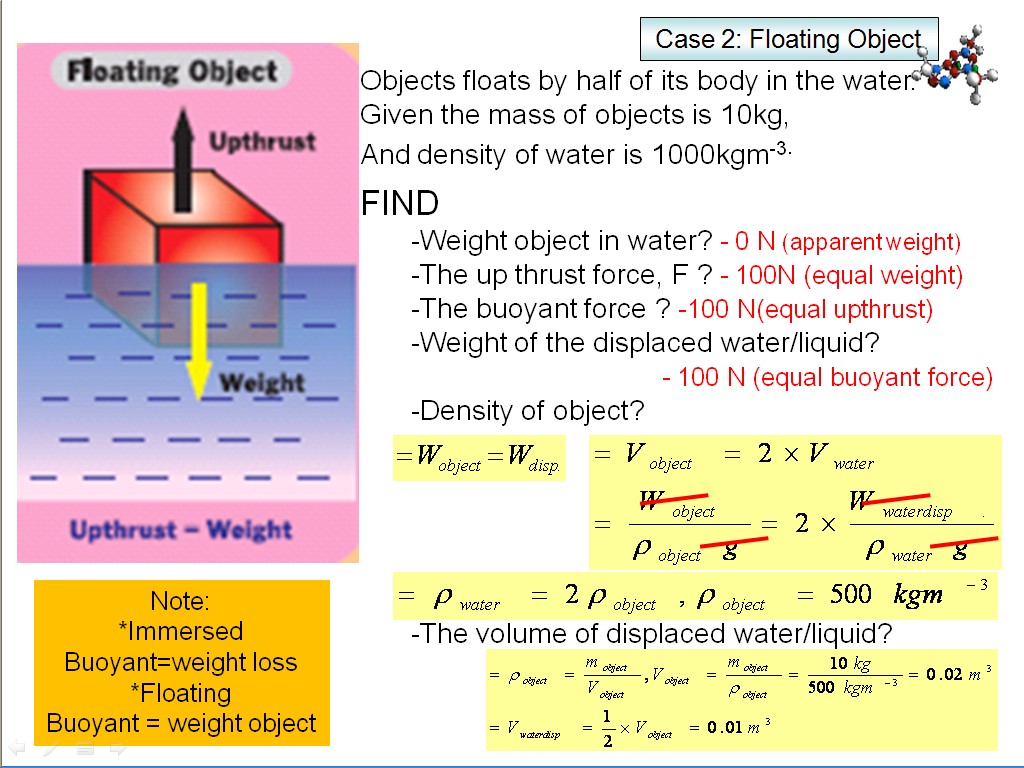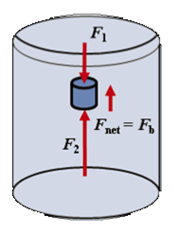

g (2) The difference in the weight of the object out of the fluid and the weight of the object while immersed in the fluid is equal to the weight of the fluid displaced, m f.According to Archimedes principle (see Appendix E: A Detailed Explanation of Buoyancy), we can write the equation: m If the first object is weighed when immersed in the fluid, it will have an apparent weight, w ′ = m ′ The first will be more dense than the fluid in which it is to be submerged, and the second will be less dense than the fluid in which it is to be submerged. In this experiment we will consider two objects. If we have an object of mass m and volume V, its density ρ (the Greek lower case letter rho) is given by: ρ = m (1) V If the object is in a vacuum or, for our purposes, air, its weight, w, will be equal to mg, where g is the acceleration due to gravity. Ring Stand Introduction Archimedes principle states: ”the buoyant force on a body in a fluid is equal to the weight of the fluid displaced by the body.” Wewillexaminethisprincipleintodayslaboratory for objects that sink and objects that float when immersed in a fluid.Ruler, Meter stick, or Vernier Calipers.You will study how the balance of forces between weight of the object and the buoyancy force on the object allow objects to float.
ARCHIMEDES PRINCIPLE EQUATION HOW TO
He came up with his now-famous principle, saw how to apply it to determine density, and ran naked down the streets of Syracuse crying “Eureka!” (Greek for “I have found it”).Description Lab 8: Buoyancy and Archimedes Principle In this lab, you will explore the force that displacing a fluid (liquid or gas) will exert on the body displacing the fluid. Archimedes purportedly agonized over his task and had his inspiration one day while at the public baths, pondering the support the water gave his body. Even ancient peoples, however, realized that the density of gold was greater than that of any other then-known substance. The purity of gold is difficult to determine by color (it can be diluted with other metals and still look as yellow as pure gold), and other analytical techniques had not yet been conceived. As the story goes, the king of Syracuse gave Archimedes the task of determining whether the royal crown maker was supplying a crown of pure gold. This brings us back to Archimedes’ principle and how it came into being. Most modern counterfeits are not pure silver. You can see from (Figure) that this density is very close to that of pure silver, appropriate for this type of ancient coin. Alternatively, on balances that measure mass, the object suffers an apparent mass loss equal to the mass of fluid displaced. The object suffers an apparent weight loss equal to the weight of the fluid displaced. This, in turn, means that the object appears to weigh less when submerged we call this measurement the object’s apparent weight. All of these calculations are based on Archimedes’ principle.Īrchimedes’ principle states that the buoyant force on the object equals the weight of the fluid displaced. This same technique can also be used to determine the density of the fluid if the density of the coin is known. The density of the coin, an indication of its authenticity, can be calculated if the fluid density is known. These two measurements are used to calculate the density of the coin.Īn object, here a coin, is weighed in air and then weighed again while submerged in a liquid. (b) The apparent weight of the coin is determined while it is completely submerged in a fluid of known density.

The buoyant force is always present whether the object floats, sinks, or is suspended in a fluid. If the buoyant force equals the object’s weight, the object will remain suspended at that depth. If the buoyant force is less than the object’s weight, the object will sink. Archimedes’ principle, physical law of buoyancy, discovered by the ancient Greek mathematician and inventor Archimedes, stating that any body completely or partially submerged in a fluid ( gas or liquid) at rest is acted upon by an upward, or buoyant, force, the magnitude of which is equal to the weight of the fluid displaced by the body. (See (Figure).) If the buoyant force is greater than the object’s weight, the object will rise to the surface and float. There is a net upward, or buoyant force on any object in any fluid. This means that the upward force on the bottom of an object in a fluid is greater than the downward force on the top of the object.

(credit: Crystl)Īnswers to all these questions, and many others, are based on the fact that pressure increases with depth in a fluid. (credit: Allied Navy) (c) Helium-filled balloons tug upward on their strings, demonstrating air’s buoyant effect. (b) Submarines have adjustable density (ballast tanks) so that they may float or sink as desired. (a) Even objects that sink, like this anchor, are partly supported by water when submerged. This book is archived and will be removed July 6, 2022.


 0 kommentar(er)
0 kommentar(er)
